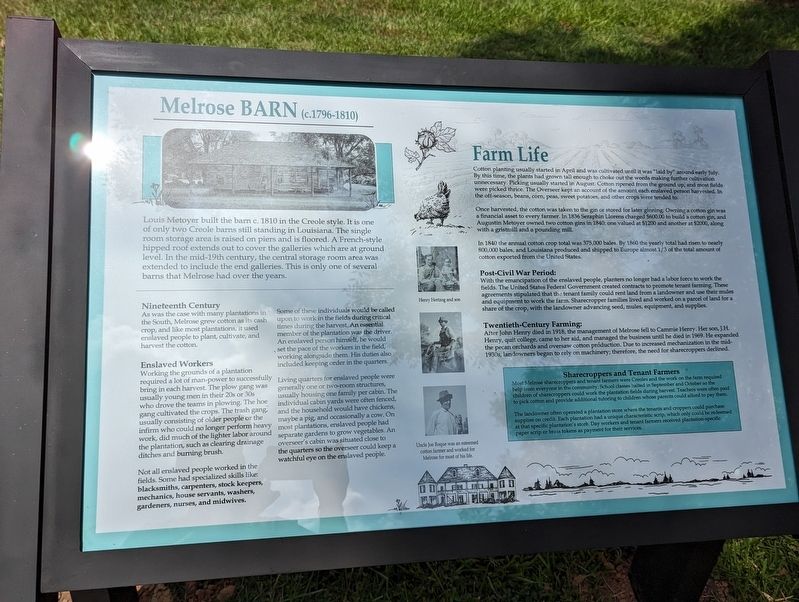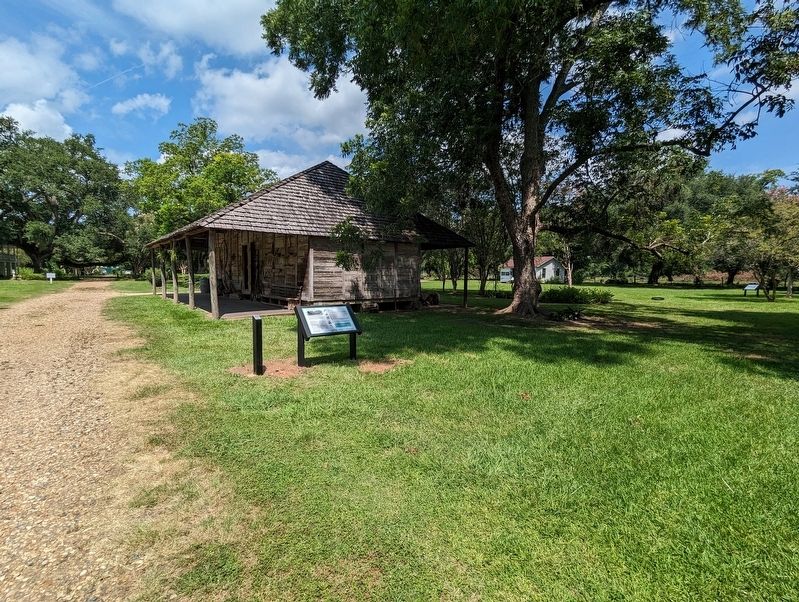Melrose in Natchitoches Parish, Louisiana — The American South (West South Central)
Melrose Barn
(c. 1796-1810)
Louis Metoyer built the barn c. 1810 in the Creole style. It is one of only two Creole barns still standing in Louisiana. The single room storage area is raised on piers and is floored. A French-style hipped roof extends out to cover the galleries which are at ground level. In the mid-19th century, the central storage room area was extended to include the end galleries. This is only one of several barns that Melrose had over the years.
Nineteenth Century
As was the case with many plantations in the South, Melrose grew cotton as its cash crop, and like most plantations, it used enslaved people to plant, cultivate, and harvest the cotton.
Enslaved Workers
Working the grounds of a plantation required a lot of man-power to successfully bring in each harvest. The plow gang was usually young men in their 20s or 30s who drove the teams in plowing. The hoe gang cultivated the crops. The trash gang, usually consisting of older people or the infirm who could no longer perform heavy work, did much of the lighter labor around the plantation, such as clearing drainage ditches and burning brush.
Not all enslaved people worked in the fields. Some had specialized skills like: blacksmiths, carpenters, stock keepers, mechanics, house servants, washers, gardeners, nurses, and midwives.
Some of these individuals would be called upon to work in the fields during critical times during the harvest. An essential member of the plantation was the driver. An enslaved person himself, he would set the pace of the workers in the field, working alongside them. His duties also included keeping order in the quarters.
Living quarters for enslaved people were generally one or two-room structures, usually housing one family per cabin. The individual cabin yards were often fenced, and the household would have chickens, maybe a pig, and occasionally a cow. On most plantations, enslaved people had separate gardens to grow vegetables. An overseer's cabin was situated close to the quarters so the overseer could keep a watchful eye on the enslaved people.
Cotton planting usually started in April and was cultivated until it was "laid by" around early July. By this time, the plants had grown tall enough to choke out the weeds making further cultivation unnecessary. Picking usually started in August. Cotton ripened from the ground up, and most fields were picked thrice. The Overseer kept an account of the amount each enslaved person harvested. In the off-season, beans, corn, peas, sweet potatoes, and other crops were tended to.
Once harvested, the cotton was taken to the gin or stored for later ginning. Owning a cotton gin was a financial asset to every farmer. In 1836 Seraphin Llorens charged $600.00 to build a cotton gin, and Augustin Metoyer owned two cotton gins in 1840: one valued at $1200 and another at $2000, along with a gristmill and a pounding mill.
In 1840 the annual cotton crop total was 375,000 bales. By 1860 the yearly total had risen to nearly 800,000 bales, and Louisiana produced and shipped to Europe almost 1/3 of the total amount of cotton exported from the United States.
Post-Civil War Period:
With the emancipation of the enslaved people, planters no longer had a labor force to work the fields. The United States Federal Government created contracts to promote tenant farming. These agreements stipulated that the tenant family could rent land from a landowner and use their mules and equipment to work the farm. Sharecropper families lived and worked on a parcel of land for a share of the crop, with the landowner advancing seed, mules, equipment, and supplies.
Twentieth-Century Farming:
After John Henry died in 1918, the management of Melrose fell to Cammie Henry. Her son, J.H. Henry, quit college, came to her aid, and managed the business until he died in 1969. He expanded the pecan orchards and oversaw cotton production. Due to increased mechanization in the mid- 1930s, landowners began to rely on machinery; therefore, the need for sharecroppers declined.
Sharecroppers and Tenant Farmers
Most Melrose sharecroppers and tenant farmers were Creoles and the work on the farm required help from everyone in the community. School classes halted in September and October so the children of sharecroppers could work the plantation fields during harvest. Teachers were often paid to pick cotton and provide additional tutoring to children whose parents could afford to pay them. The landowner often operated a plantation store where the tenants and croppers could purchase supplies on credit. Each plantation had a unique characteristic scrip, which only could be redeemed at that specific plantation's store. Day workers and tenant farmers received plantation-specific paper scrip or brass tokens as payment for their services.
Topics. This historical marker is listed in these topic lists: Agriculture • Settlements & Settlers.
Location. 31° 36.016′ N, 92° 57.964′ W. Marker is in Melrose, Louisiana, in Natchitoches Parish. Marker can be reached from State Highway 119, half a mile south of State Route 493. Touch for map. Marker is at or near this postal address: 3533 LA-119, Melrose LA 71452, United States of America. Touch for directions.
Other nearby markers. At least 8 other markers are within walking distance of this marker. Ghana House (within shouting distance of this marker); Clemetine Hunter Home and Studio (within shouting distance of this marker); The Bindry (within shouting distance of this marker); Weaving House (within shouting distance of this marker); Yucca Plantation (within shouting distance of this marker); Big House (within shouting distance of this marker); African House and Clementine Hunter's Murals (about 300 feet away, measured in a direct line); Yucca House (about 400 feet away). Touch for a list and map of all markers in Melrose.
More about this marker. Located on the grounds of the Melrose Plantation. Admission required for either a self walking grounds tour, or guided tour of entire complex.
Credits. This page was last revised on July 21, 2023. It was originally submitted on July 21, 2023, by Cajun Scrambler of Assumption, Louisiana. This page has been viewed 67 times since then and 16 times this year. Photos: 1, 2. submitted on July 21, 2023, by Cajun Scrambler of Assumption, Louisiana.

